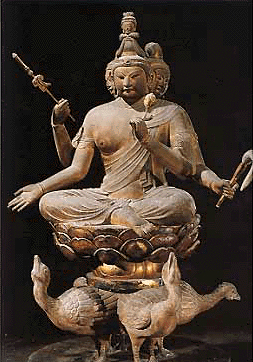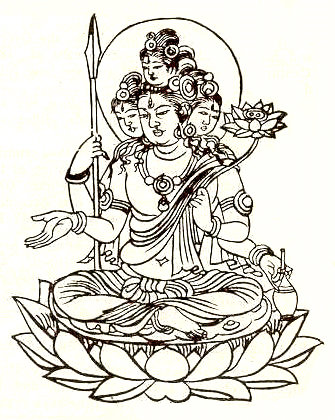
|
|
|
|
Vishnu deities and images of Ganesha are found throughout Japan, along with various other Vedic deities who were incorporated into, and amalgamated with, Buddhist personalities. Indra, for example, became known in Japan as Taishaku, meaning the 'great King Sakra'. You'll recall that in the pastime of Lord Buddha, Brahma and Indra descending the ladder, Indra was known as Sakka. The similarity in names indicates how the Buddhist influence traveled to Japan with Indra. Shiva is known in Japan as Daikoku. Ganesh as Sho-ten, Sesanaga as Ryujin, Kuvera as Bishamon, and Varuna as Sui-ten. Lord Brahma and Saraswati Devi have both been incorporated into the Japanese pantheon. Saraswati is known as Ben-ten, and Brahmadeva as Bon-ten, although Brahma is sometimes also referred to as Ben-ten. There are many Saraswati shrines found along the Japanese coast, and besides bodies of water like ponds and lakes. She is known here as the goddess of speech.
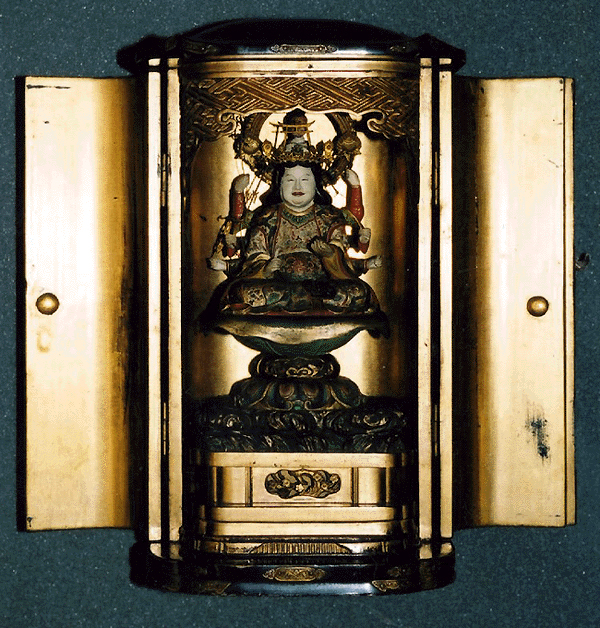
Japanese Ben-ten (Saraswati) shrine Gilded, lacquered wood, 18th c. This eight-armed image of Devi Saraswati as Ben-ten has eight arms, an iconography described in esoteric Buddhism. She holds the Wheel of Law and other paraphernalia, and has a distinctly Chinese look.
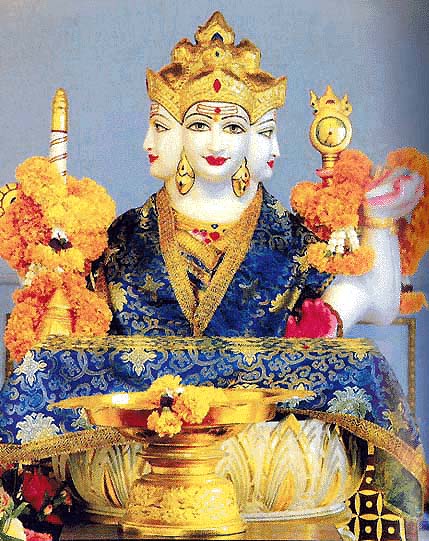
Lord Brahma as Phra Prom
In Thailand, Lord Brahma is known as Phra Prom, the first born, and a member of the divine Trimurti. In March 2006, one of the most famous Brahma deities outside of India was attacked and severely damaged by a madman, in central Bangkok. The deity resides in an open-air shrine there, installed in 1956 beside the Erawan Hotel, which was named after Brahmadeva's 33-headed elephant. (Brahma once gave Indra an elephant, also named Erawan.) In May 2006, the Sun ran a Feature Story on the re-opening of the shrine, after the deity was restored.
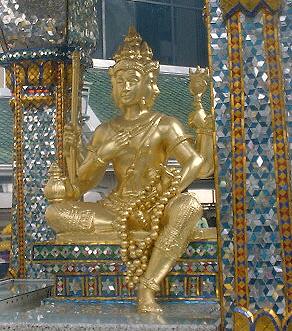
Lord Brahma, Erawan Shrine The idea of Lord Brahma being installed outside, beside a hotel might seem odd, until one visits Thailand. They will find that Lord Brahma is an extremely popular deity there – far more than in India, and probably more than anywhere else in the world, outside of Cambodia and Java. There are countless shrines dedicated to Brahma in Thai cities and villages, and like Ganesh in India, he is often found around commercial centers, where he is believed to bring prosperity and success.
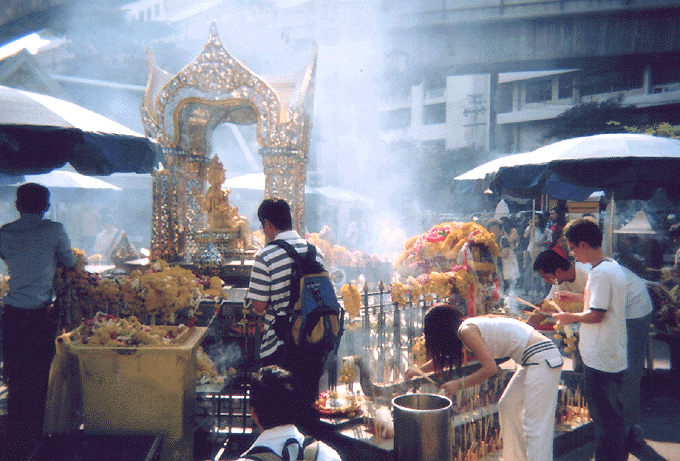
Lord Brahma's Erawan Shrine in a cloud of incense 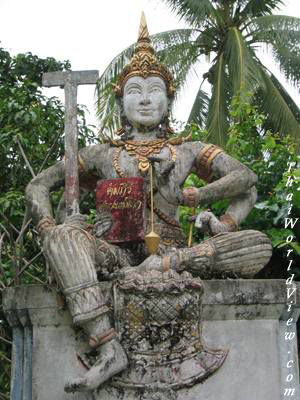
Phra Prom in Cambodia
Like Thailand, there are many images of Lord Brahma found throughout Cambodia. Most show a heavy Buddhist influence in style and iconography. There are many sacred sites where exquisite Brahmadeva sculptures are found in multiple, including Phnom Phen, Angkor Wat, Bayon, and Kbal Spean. At the latter site, there are several underwater images of Brahma, Visnu, and other Vedic deities, carved into the rock of stream beds.
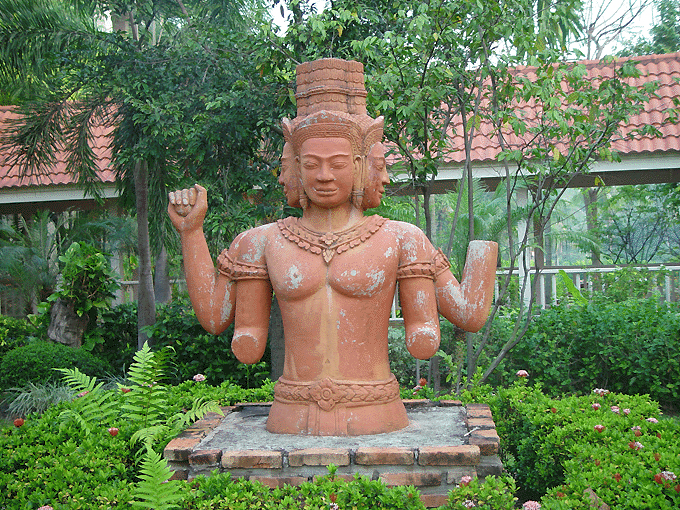
Brahma at Sofitel Hotel Angkor Wat, Cambodia 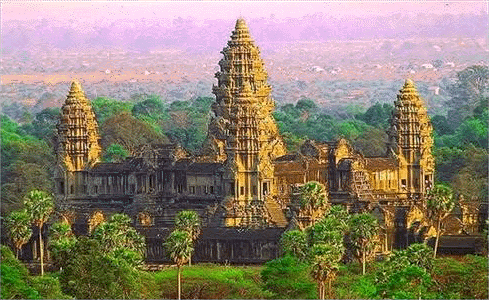
Angkor Wat One of the most stunning rock carvings of Lord Brahma is found at Angkor Wat. Known as the Maganamous Brahma, this massive rock sculpture is comprised of carved blocks, installed to look like a mountaintop, carved with Brahma's four faces.
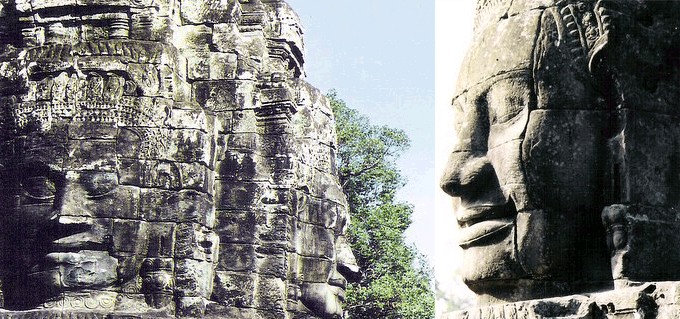
Maganamous Brahma, Angkor Wat In Banteay Chhmar, Cambodia there is an excellent sculpture cut into a low pediment in the temple compound's eastern pavilion. Although defaced by ruffians, it still bears a beautiful image of Lord Brahma. The pastime is from Valmiki's Ramayana, known as Reamker in Cambodia. The sage Valmiki was in the forest looking for somewhere to take bath. While he was admiring a pair of mating cranes, a hunter in the forest killed the male bird with an arrow. In the carved panel, you can see the arrow going through the neck of both birds. It is said that witnessing this caused Valmiki to pour all his emotions out into the story of Sita and Rama. Lord Brahma sits at the center of the image, in catur-mukha form. The style of Brahma in this carving is more Indian than typical Cambodian, although the harp player is done in Cambodian style. Valmiki sits beside Lord Brahma, but unfortunately his face has been disfigured. To the left is a harp player. The whole scene takes place under the stretched body of a naga. We're not sure what the significance is of Brahma being placed in this scene, but assume it has to do with his role as the creator, in relationship to the death of the crane.
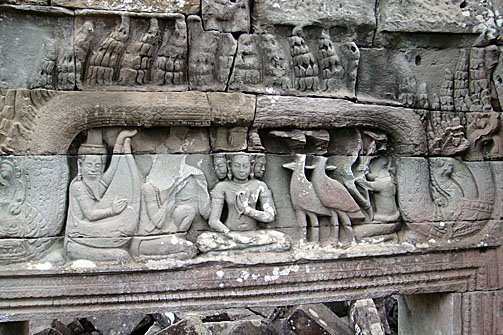
Lord Brahma, Valmiki and the Hunter Banteay Chhmar, Cambodia
| |
